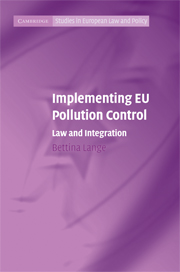Book contents
- Frontmatter
- Contents
- Series editors’ preface
- Acknowledgements
- Update on the IPPC Directive
- Abbreviations
- 1 Introduction
- 2 Traditional perspectives on the role of law in EU integration
- 3 Critical perspectives on the role of law in EU integration
- 4 What is EU ‘law in action’?
- 5 Talking interests – generating procedure: How political discourse constructs key aspects of BAT determinations in BREFs
- 6 Variation in open and closed BAT norms
- 7 What does it cost? Economic discourse in the determination of ‘the best available techniques’ under the IPPC directive
- 8 Does ‘law’ integrate? Licensing German and English coke ovens under the IPPC Directive
- 9 Conclusion
- Appendix: Methodology
- Bibliography
- Index
6 - Variation in open and closed BAT norms
Published online by Cambridge University Press: 07 August 2009
- Frontmatter
- Contents
- Series editors’ preface
- Acknowledgements
- Update on the IPPC Directive
- Abbreviations
- 1 Introduction
- 2 Traditional perspectives on the role of law in EU integration
- 3 Critical perspectives on the role of law in EU integration
- 4 What is EU ‘law in action’?
- 5 Talking interests – generating procedure: How political discourse constructs key aspects of BAT determinations in BREFs
- 6 Variation in open and closed BAT norms
- 7 What does it cost? Economic discourse in the determination of ‘the best available techniques’ under the IPPC directive
- 8 Does ‘law’ integrate? Licensing German and English coke ovens under the IPPC Directive
- 9 Conclusion
- Appendix: Methodology
- Bibliography
- Index
Summary
Introduction
Chapters 2 and 3 analysed how law is conceptualised in the various contributions to the literature on EU integration. Chapter 2 identified a traditional approach which draws in particular on images of law generated by official supranational and national legal systems themselves. This perspective interprets law as formal, instrumental and relatively autonomous in relation to its social contexts. Chapter 3 examined critical perspectives which suggest that EU law has now assumed various forms. I argued that these critical perspectives abandon instrumental and relatively autonomous conceptions of law only to a limited extent. Even if the term ‘law’ is employed to refer to a variety of norms beyond official EU and member state law, law is still regarded as a clearly delimited domain with a specific normative content, although, in the case of soft law, this content is not formally legally binding.
This chapter further develops the discussion about the nature of EU law. It argues that implementation of the EU Directive on Integrated Pollution Prevention and Control in practice generates various types of EU law. It generates open and closed BAT norms. According to the IPPC Directive's key legal obligation operators of mainly industrial installations have to employ ‘the best available techniques’. Sometimes, there is a clear and specific definition of what the ‘best available techniques’ are, either for a whole industrial sector or for a specific installation. But at other times there is no specific, clear outcome to BAT determination processes.
- Type
- Chapter
- Information
- Implementing EU Pollution ControlLaw and Integration, pp. 142 - 190Publisher: Cambridge University PressPrint publication year: 2008



